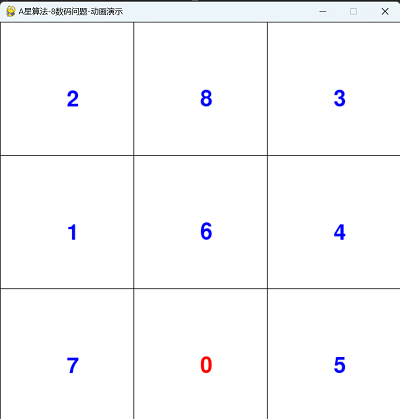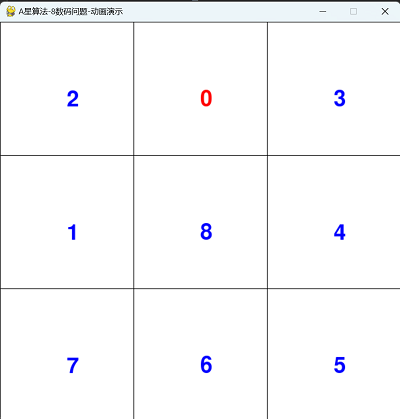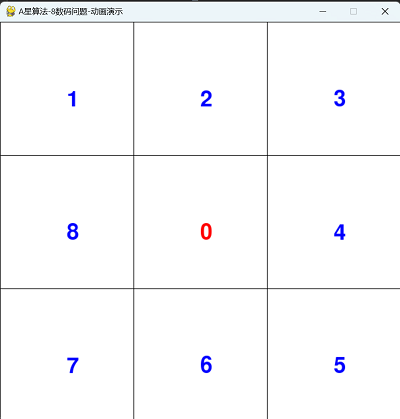- 1带你玩转PYNQ-Z2开发板 系列教程(一)—准备工作_pynq computer vision: getting started with pynq-z2
- 2FPGA秋招-笔记整理(1)
- 3【python】MQTT协议基础(简介+代码)
- 4【论文笔记】RS-Mamba for Large Remote Sensing Image Dense Prediction(附Code)
- 5JSON 与 对象 、集合 之间的转换_json 对象集合
- 6Hist2ST:联合Transformer和图神经网络从组织学图像中进行空间转录组学预测
- 7conda使用问题——CondaValueError: too few arguments, must supply command line package specs or --file
- 8信息安全技术网络安全等级保护基本要求GB/T 22239一2019(第一级安全要求)
- 9springboot3整合SpringSecurity实现登录校验与权限认证(万字超详细讲解)_springboot3 security
- 10牛客小白月赛36_卷王之王 题解
人工智能-A*算法-八数码问题_a*算法解决八数码问题
赞
踩
一,A*算法设计思想
A*算法(A-star)是一种寻路算法,主要用于游戏、机器人等领域。
它的设计思想是将最短路径搜索问题转化为一个优化问题,通过计算每个节点的评分(f(n) = g(n) + h(n))来寻找最优路径。
以下是 A*算法的设计思想:
1. 引入启发式函数(h(n)):
A*算法使用一个启发式函数来估计从当前节点到目标节点的距离。
启发式函数越好,搜索速度越快。
通常情况下,启发式函数为曼哈顿距离(曼哈顿距离是指两点在网格上沿着网格线走的距离之和)。
2. 优先级队列:
A*算法使用一个优先级队列(开启列表)来存储待处理的节点。
队列中的节点按照评分(f(n))从高到低排列。
这样,每次迭代都可以优先处理评分最高的节点,从而保证搜索的速度和效率。
3. 扩展节点:
A*算法从当前节点开始,遍历其所有相邻节点。
对于每个相邻节点,检查它是否在关闭列表中(表示已经访问过),如果不在关闭列表中,则将其加入开启列表,并更新其父节点和评分。
4. 关闭列表:
A*算法使用一个关闭列表来记录已访问过的节点。
每次扩展节点时,都需要检查新节点是否在关闭列表中。
如果在,则忽略该节点,继续处理其他相邻节点。
5. 停止条件:
A*算法在找到目标节点或开启列表为空时停止搜索。
找到目标节点时,意味着找到了一条从起始节点到目标节点的最短路径。
6. 回溯法:
当开启列表为空时,搜索失败。
此时,可以使用回溯法(如 Dijkstra 算法)从起始节点开始,重新寻找一条路径。
这种情况下,A*算法退化为 Dijkstra 算法。
二,题目需求
应用启发式搜索算法A 解决以下八数码问题:
初始状态:

目标状态:

三,代码实现
完整代码,需要下载pygame库,直接使用,运行可以查看动画演示效果。
- import heapq
- from copy import deepcopy
- import time
- import pygame
-
-
- # 定义启发式函数,使用当前状态与目标状态,棋子的错位数作为估价值
- def heuristic(move_state, goal_state):
- err_num = 0
- for i in range(3):
- for j in range(3):
- if move_state[i][j] != goal_state[i][j]:
- err_num += 1
- return err_num
-
-
- # 根据当前状态,获取可移动方向
- def get_moves(state, g):
- # 获取空缺位(或0值)坐标
- x, y = None, None
- for i in range(3):
- for j in range(3):
- if state[i][j] == 0:
- x, y = i, j
- break
- moves = []
- if x > 0:
- new_state = deepcopy(state)
- # 空位与它左侧1位交换,左侧数字右移
- new_state[x][y], new_state[x - 1][y] = new_state[x - 1][y], new_state[x][y]
- moves.append((new_state, g + 1))
- if x < 2:
- new_state = deepcopy(state)
- # 空位与它右侧1位交换,右侧数字左移
- new_state[x][y], new_state[x + 1][y] = new_state[x + 1][y], new_state[x][y]
- moves.append((new_state, g + 1))
- if y > 0:
- new_state = deepcopy(state)
- # 空位与它下面1位交换,下面数字上移
- new_state[x][y], new_state[x][y - 1] = new_state[x][y - 1], new_state[x][y]
- moves.append((new_state, g + 1))
- if y < 2:
- new_state = deepcopy(state)
- # 空位与它上面1位交换,上面数字下移
- new_state[x][y], new_state[x][y + 1] = new_state[x][y + 1], new_state[x][y]
- moves.append((new_state, g + 1))
- return moves
-
-
- # A星算法搜索
- def a_star_search(initial_state, goal_state):
- f, g, h = 0, 0, 0
- open_set = [(f, initial_state)]
- close_set = set()
- # 从哪里来字典,记录节点来源,当成父节点
- come_from = {}
- while open_set:
- f, current_state = heapq.heappop(open_set)
- if current_state == goal_state:
- data = []
- current_state = tuple(map(tuple, current_state))
- # 从目标点向起点遍历路径
- while current_state in come_from:
- # 将当前点的位置加入路径
- data.append(current_state)
- # 将当前点设为从哪里来的节点,继续向上遍历
- current_state = come_from[current_state]
- # 将起始点的位置也加入路径
- data.append(tuple(map(tuple, initial_state)))
- # 将路径反转,因为我们是从目标向起点遍历的,所以需要反转得到真正的路径
- return data[::-1]
-
- close_set.add(tuple(map(tuple, current_state)))
- for move, g in get_moves(current_state, g):
- if tuple(map(tuple, move)) not in close_set:
- come_from[tuple(map(tuple, move))] = tuple(map(tuple, current_state))
- h = heuristic(move, goal_state)
- f = g + h
- heapq.heappush(open_set, (f, move))
- return None
-
-
- # 打印网格地图
- def grid_print(grid):
- for line in grid:
- print(line)
-
-
- # 定义网格矩阵长宽
- map_size = (3, 3)
- # 定义屏幕一个格子大小
- CELL_SIZE = 200
- # 定义屏幕宽高大小
- WIDTH, HEIGHT = map_size[0] * CELL_SIZE, map_size[1] * CELL_SIZE
-
- # 定义颜色
- WHITE = (255, 255, 255)
- RED = (255, 0, 0)
- BLUE = (0, 0, 255)
- BLACK = (0, 0, 0)
-
-
- # 绘制主地图,棋盘数字
- def draw_grid(pygame, screen, num_states):
- # 填充屏幕背景为白色
- screen.fill(WHITE)
- for i in range(0, WIDTH, CELL_SIZE):
- pygame.draw.line(screen, BLACK, (i, 0), (i, HEIGHT))
- for i in range(0, HEIGHT, CELL_SIZE):
- pygame.draw.line(screen, BLACK, (0, i), (WIDTH, i))
- # 字体
- font = pygame.font.Font(None, 48)
- for i in range(3):
- for j in range(3):
- # 数字值
- num_text = str(num_states[j][i])
- if num_text == '0':
- # 写数字
- text = font.render(num_text, True, RED)
- else:
- # 写数字
- text = font.render(num_text, True, BLUE)
- screen.blit(text, (i * CELL_SIZE + CELL_SIZE / 2, j * CELL_SIZE + CELL_SIZE / 2))
-
-
- # 绘制A*算法找到的路径,动画演示
- def draw_a_star_path(initial_state, goal_state):
- # 执行A*算法,寻找最优路径
- path_states = a_star_search(initial_state, goal_state)
- print("绘制网格地图和最优路径:")
- # 返回搜索路径和Open、Close表的内容
- i = 0
- for path in path_states:
- grid_print(path)
- print(f"======={i}=======")
- i += 1
-
- print("绘制A*算法找到的路径地图:")
- # 初始化 Pygame
- pygame.init()
-
- # 创建一个窗口(屏幕)对象
- screen = pygame.display.set_mode((WIDTH, HEIGHT))
- # 窗口描述
- pygame.display.set_caption("A星算法-8数码问题-动画演示")
- # 循环刷新地图,显示最优路径
- for num_states in path_states:
- # 绘制主地图,棋盘数字
- draw_grid(pygame, screen, num_states)
- # 更新显示屏幕
- pygame.display.flip()
- time.sleep(1)
- # 退出 Pygame
- pygame.quit()
-
-
- if __name__ == "__main__":
- # 八数码初始状态
- initial_state = [
- [2, 8, 3],
- [1, 6, 0],
- [7, 5, 4]
- ]
-
- # 八数码最终状态
- goal_state = [
- [1, 2, 3],
- [8, 0, 4],
- [7, 6, 5]
- ]
- # 绘制A*算法找到的路径,动画演示
- draw_a_star_path(initial_state, goal_state)

四,运行动画效果








==========结束==========


